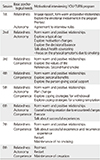Abstract
Purpose
In this study, the effectiveness of a motivational interviewing smoking cessation YOU-TURN program for adolescents was examined. The program was based on the self-determination theory.
Methods
The study was carried out with a nonequivalent control group pretest-posttest design. Participants in the present study were 136 high school students living in D city. The students were assigned to the experimental group (n=52) who participated in the motivational interviewing smoking cessation YOU-TURN program based on self-determination theory, or to the control group (n=84) who participated in a general smoking cessation program. Data were collected from September 1, 2013 through April 30, 2014. Collected data were analyzed using SPSS PC+ 21.0 with Chi-square test, Fisher's exact test, t-test, Mann-Whitney U test, Repeated Measures ANOVA, and MANOVA-Wilk's Lambda.
Figures and Tables
References
1. Ministry of Education. Ministry of Health and Welfare. Korea Centers for Disease Control and Prevention. The ninth Korea youth risk behavior web-based survey. Seoul: Author;2013.
2. Chung HK. A phenomenological approach to high school student's smoking experiencing. J Korean Acad Nurs. 2001; 31(4):610–618.
3. Lim Y, Lee JH, Kim SI, Hahm JS. Adolescent smoking behavior: Personality, motivation, craving, nicotine dependence. Korean J Youth Stud. 2003; 10(3):461–479.
4. Yi YJ, Lee KJ, Kim YS. Influences of demographic, smoking, and smoking cessation factors on smoking cessation success in adolescent smokers. J Korea Contents Assoc. 2011; 11(4):303–311. DOI: 10.5392/JKCA.2011.11.4.303.
5. Kim YS, Jeong BR. An analysis of articles related to smoking and smoking cessation of Korean adolescents. J Korean Acad Community Health Nurs. 2010; 21(1):53–62. DOI: 10.12799/jkachn.2010.21.1.53.
6. Kim HK, Park JY, Kwon EJ, Choi SH, Cho HI. Efficacy of smoking cessation and prevention programs by intervention methods: A systematic review of published studies in Korean journals during recent 3 years. Korean J Health Educ Promot. 2013; 30(5):61–77. DOI: 10.14367/kjhep.2013.30.5.061.
7. Im SH, Choi HS, Kwon SJ, Kim SJ, Kim KH. Development of a youth game addition intervention program based on the self-determination theory: Preliminary research for the development of win-me gameTM. Korean J Health Psychol. 2012; 17(4):861–883.
8. Kim YS, Lee KJ, Yi YJ. Comparison of the characteristics of smoking cessation success between short-term and long-term success groups. J Korean Acad Community Health Nurs. 2009; 20(2):251–258.
9. Deci EL, Ryan RM. Facilitating optimal motivation and psychological well-being across life's domains. Can Psychol. 2008; 49(1):14–23. DOI: 10.1037/0708-5591.49.1.14.
10. Ha YS, Choi YH. Effectiveness of a motivational interviewing smoking cessation program on cessation change in adolescents. J Korean Acad Nurs. 2012; 42(1):19–27. DOI: 10.4040/jkan.2012.42.1.19.
11. Kohler CL, Schoenberger YM, Tseng TS, Ross L. Correlates of transitions in stage of change for quitting among adolescent smokers. Addict Behav. 2008; 33(12):1615–1618. DOI: 10.1016/j.addbeh.2008.07.014.
12. Slesnick N, Meyers RJ, Meade M, Segelken DH. Bleak and hopeless no more. Engagement of reluctant substance-abusing runaway youth and their families. J Subst Abuse Treat. 2000; 19(3):215–222.
13. Deci EL, Ryan RM. The "what" and "why" of goal pursuits: Human needs and the self-determination of behavior. Psychol Inq. 2000; 11(4):227–268. DOI: 10.1207/S15327965PLI1104_01.
14. Miller WR, Rollnick S, Conforti K.
SM Shin
JO Kwon
MJ Son
. Motivational interviewing: Preparing people for change. 2nd ed. New York, NY: Guilford Publications;2002.
15. Patrick H, Williams GC. Self-determination theory: Its application to health behavior and complementarity with motivational interviewing. Int J Behav Nutr Phys Act. 2012; 9:18. DOI: 10.1186/1479-5868-9-18.
16. Park GR, Kim HS. Effects of a group counseling integration program on self-determination and internet addiction in high school students with tendency to internet addiction. J Korean Acad Nurs. 2011; 41(5):694–703. DOI: 10.4040/jkan.2011.41.5.694.
17. Lee E, Park JW. A structural equation model on health behavior adherence for elders with prehypertension: Based on self-determination theory. J Korean Acad Fundam Nurs. 2012; 19(3):343–352.
18. Cho JH. Effects of a motivation-enhanced weight loss program for women with abdominal obesity: Based on the self-determination theory [dissertation]. Seoul: Korea University;2012.
19. Williams GC, McGregor HA, Sharp D, Levesque C, Kouides RW, Ryan RM, et al. Testing a self-determination theory intervention for motivating tobacco cessation: Supporting autonomy and competence in a clinical trial. Health Psychol. 2006; 25(1):91–101. DOI: 10.1037/0278-6133.25.1.91.
20. Lee M, Kim A. Development and construct validation of the basic psychological needs scale for Korean adolescents: Based on the self-determination theory. Korean J Soc Pers Psychol. 2008; 22(4):157–174.
21. Waltz CF, Bausell BR. Nursing research: Design statistics and computer analysis. Philadelphia, PA: F. A. Davis Company;1981.
22. Korea Health Promotion Foundation. END: Experience new days. Seoul: Author;2012.
23. Jeon SH, Sihn M, Yoo MS. Analysis of the structural relationships among parental monitoring, self-determination, and happiness. Korean J Play Ther. 2011; 14(2):73–87.
24. Choi J, Park DJ, Noh GY. The content analysis of Korean smoking cessation apps for smartphone: Application of the self-determination theory. J Public Relat Res. 2013; 17(2):76–110.
25. Kim MS, Kwon JH. The outcome study of cognitive behavioral and behavioral smoking abstinence program for Korean nicotine dependent adolescents. Korean J Clin Psychol. 2006; 25(1):1–23.
26. Choe EY, Jeong SH. The effect of self-efficacy promotion smoking cessation program on the amount of smoking, CO, urine cotinine level and self-efficacy for adolescent smokers. J Korean Biol Nurs Sci. 2012; 14(2):103–111. DOI: 10.7586/jkbns.2012.14.2.103.
27. Suh KH, Lee SM. Psychological factors associated with short-term and long-term abstention following a smoking cessation program. J Korean Soc Health Educ Promot. 2004; 21(1):137–151.
28. Jee YJ, Lee H, Lim Y. Effects of a smoking cessation program using self-regulated learning strategy for middle school boys. J Korean Acad Psychiatr Ment Health Nurs. 2011; 20(1):1–12. DOI: 10.12934/jkpmhn.2011.20.1.1.




 PDF
PDF ePub
ePub Citation
Citation Print
Print






 XML Download
XML Download